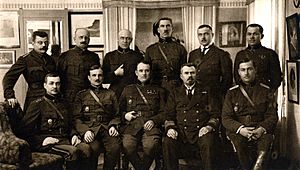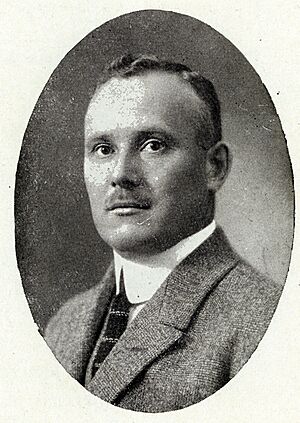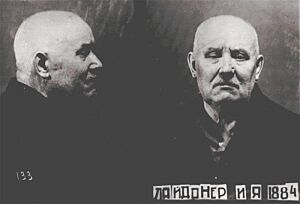Johan Laidoner facts for kids
Quick facts for kids
Johan Laidoner
|
|
|---|---|

Laidoner during the Estonian War of Independence.
|
|
| Born | 12 February 1884 Vardja, Viiratsi, Governorate of Livonia, Russian Empire |
| Died | 13 March 1953 (aged 69) Vladimir, Russian SFSR, Soviet Union |
| Allegiance | |
| Service/ |
Imperial Russian Army Estonian Army |
| Years of service | 1901–1920 1924–1925 1934–1940 |
| Rank | Kindral (General) |
| Commands held | Commander‑in‑Chief of the Estonian Armed Forces |
| Battles/wars | World War I Estonian War of Independence |
| Awards | Cross of Liberty, 1st Class 1st Rank Cross of Liberty, 3rd Class 1st Rank Order of the White Star Order of the Cross of the Eagle, 1st Class Order of the Estonian Red Cross, 1st Class |
| Spouse(s) |
Maria Kruszewska
(m. 1911) |
| Signature |  |
Johan Laidoner (born February 12, 1884 – died March 13, 1953) was an important Estonian general and leader. He was the Commander-in-Chief of the Estonian Armed Forces during the Estonian War of Independence from 1918 to 1920. He was also one of the most influential people in Estonian politics between the two World Wars.
Born in Viiratsi, he joined the Imperial Russian Army in 1901 and fought in World War I. After the Russian Revolution in 1917, he led Estonian military groups within the Russian army. In 1918, when Estonia became independent, he was chosen to lead its armed forces.
After the War of Independence, he served in the Estonian parliament from 1920 to 1929. He was called back to lead the army during a Communist coup attempt in 1924. He served as commander-in-chief again from 1934 to 1940. After the Soviet Union took over Estonia in 1940, he was arrested. He was sent to Russia, where he died in prison in 1953.
Contents
Early Life and Military Training
Johan Laidoner was born on a farm in Vardja. His parents, Jaak and Mari, were not wealthy. He went to elementary school and finished his basic education in Viljandi in 1900. Because his family was poor, he decided to join the Imperial Russian Army in 1901.
From 1901 to 1902, he served in an infantry regiment in Kovno (now Kaunas, Lithuania). He then studied at the Infantry Officer School in Vilna (Vilnius) from 1902 to 1905. He was a very good student and graduated at the top of his class. In April 1905, he became a sub-lieutenant. He then served in a grenadier regiment in Georgia. He held different roles there and became a lieutenant in 1908.
From 1909 to 1912, Laidoner studied at the Imperial Nicholas Military Academy in Saint Petersburg. He graduated with high honors. While studying there, he married Maria Skarbek-Kruszewska in 1911. She came from a Polish noble family. They had a son named Michael, who sadly passed away in 1928. After Michael's death, they adopted Maria's nephew, Aleksei.
In 1912, Laidoner became a staff captain. He returned to his regiment and later joined the General Staff. He also spent a year as a company commander.
World War I Experience
When World War I began, Laidoner was a staff aide in the 3rd Caucasus Army Corps. He was promoted to captain in November 1914. In 1915, he joined the senior staff of the 21st Infantry Division. Later that year, he became an aide for the intelligence department of the Western Front. In August 1916, he was promoted to Podpolkovnik (lieutenant colonel).
From March to November 1917, he served as a staff commander for different divisions. On January 5, 1918, Laidoner was appointed commander of the new 1st Estonian Division. However, peace talks broke down, and German forces landed in Estonia. Laidoner resigned and left for Russia. Estonia declared independence on February 24, 1918, but was soon occupied by Germany.
Leading Estonia in the War of Independence
On April 4, 1918, the Estonian Provisional Government promoted Laidoner to Polkovnik (colonel). After Germany surrendered on November 11, 1918, the Soviet Red Army invaded Estonia on November 28. This started the Estonian War of Independence. Laidoner returned to Tallinn in December. He was first made chief of staff, then on December 23, he became the Commander-in-Chief of the Estonian Armed Forces.
On January 1, 1919, the Estonian Army had just over 13,000 soldiers. About 5,700 of them faced 8,000 Soviet soldiers on the Viru Front. In early January, Estonian forces stopped the Soviet advance. On January 3, Laidoner launched a counter-attack. His 1st Division was supported by Finnish volunteers and armoured trains.

Within 11 days, the 1st Division advanced 200 kilometers east. The 2nd Division moved against Soviet forces in Southern Estonia. After freeing Tartu and Narva, Laidoner was promoted to major general on January 20, 1919. On Estonia's first independence day on February 24, 1919, Laidoner announced that Soviet forces had been driven out of Estonia.
Laidoner was key in quickly organizing and training the army. He created a strong command structure. He used his experience from World War I. He knew that with limited forces, he needed to win key battles by capturing important roads and railway stations. He used smaller, faster units like battalions and companies, supported by armored trains and cars. After the war ended, Laidoner was promoted to lieutenant general on March 21, 1920. He then resigned as commander-in-chief and left military service on March 26, 1920.
After the War
After the war, Laidoner became a member of the Riigikogu (Estonian Parliament). From 1920 to 1929, he was part of the conservative Farmers' Assemblies party. He led the Foreign Affairs Committee. He was also part of Estonia's group at the League of Nations from 1922 to 1929. There, he was known for wanting Estonia to stay out of other countries' problems.
On December 1, 1924, Estonian Communists, with help from the Soviet Union, tried to take over the government. The government declared a state of emergency. Laidoner was again appointed commander-in-chief of the armed forces. The coup attempt ended in five hours, but the search for those involved continued for weeks. On January 8, 1925, after the emergency was over, Laidoner resigned from military service again.
In 1925, the League of Nations asked Laidoner to lead a special mission to Iraq. He investigated claims that Turkey was mistreating Christians in the Mosul area. His committee's report helped decide the border between Turkey and Iraq.
On March 12, 1934, the State Elder Konstantin Päts declared martial law (military rule). He appointed Laidoner commander-in-chief of the armed forces once more. This was done to stop the political rise of the Vaps Movement. Laidoner, along with Päts and Minister of the Interior Kaarel Eenpalu, created an authoritarian rule. They ended political parties and limited free speech. This time was known as the "Era of Silence". Laidoner remained commander-in-chief and managed national defense. He started programs to update weapons and equipment. He also expanded the military through conscription (requiring people to join the army) and added military training to universities. On January 1, 1938, a new constitution was put in place. Laidoner became a member of the National Council because of his position. On February 24, 1939, he was promoted to the rank of general.
Soviet Occupation and Death
On June 17, 1940, the Soviet Union occupied Estonia. Laidoner was officially removed from his position on June 22, 1940. On July 19, he and his wife were sent away to Penza, Russia. They lived there in forced exile until World War II began. On June 23, 1941, they were put under house arrest. Then, on June 28, they were imprisoned by the NKVD (Soviet secret police).
In September 1942, the Laidoners were sent to the Butyrka prison in Moscow. Other former leaders from Latvia, Lithuania, and Poland were also there. They were later moved to prisons in Kirov and Ivanovo. On April 16, 1952, Laidoner was sentenced to 25 years in prison. He was sent to Vladimir Central Prison, where he died on March 13, 1953. He was buried in the prison cemetery, but his remains have never been found.
Laidoner's adopted son, Aleksei, was also arrested by the NKVD. He died in a labor camp in Solikamsk in 1941. Maria Laidoner, Johan's wife, was released in 1954. She was allowed to return to Estonia. She died in 1978 and was buried in Tallinn next to her son Michael.
Laidoner's Legacy
Johan Laidoner's reputation in Estonia is still discussed. He is seen as a national hero for his strong leadership and success in the War of Independence. However, he has also been criticized for supporting Konstantin Päts and his role in the 1934 government changes. He is also criticized for Estonia's surrender to the Soviet Union in 1940.
Many places and memorials are named after Laidoner:
- His memorial in his birthplace in Vardja was destroyed by the Soviets in 1940. It was rebuilt in 1990.
- In 2001, the Estonian War Museum was opened in Laidoner's former home, Viimsi Manor. It is named in his honor.
- In 2004, a statue of General Laidoner on horseback was unveiled near the ruins of the Viljandi Castle.
- In Viljandi, a square and a park are named after him.
- In 2009, Eesti Post released a special stamp to celebrate Laidoner's 125th birthday.
- There is a plaque dedicated to him in the Vilnius Military Academy.
Images for kids
See also
- Estonian War of Independence
- Gustaf Mannerheim










